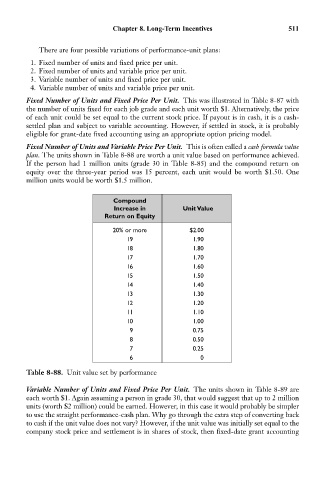Page 525 - Bruce Ellig - The Complete Guide to Executive Compensation (2007)
P. 525
Chapter 8. Long-Term Incentives 511
There are four possible variations of performance-unit plans:
1. Fixed number of units and fixed price per unit.
2. Fixed number of units and variable price per unit.
3. Variable number of units and fixed price per unit.
4. Variable number of units and variable price per unit.
Fixed Number of Units and Fixed Price Per Unit. This was illustrated in Table 8-87 with
the number of units fixed for each job grade and each unit worth $1. Alternatively, the price
of each unit could be set equal to the current stock price. If payout is in cash, it is a cash-
settled plan and subject to variable accounting. However, if settled in stock, it is probably
eligible for grant-date fixed accounting using an appropriate option pricing model.
Fixed Number of Units and Variable Price Per Unit. This is often called a cash formula value
plan. The units shown in Table 8-88 are worth a unit value based on performance achieved.
If the person had 1 million units (grade 30 in Table 8-85) and the compound return on
equity over the three-year period was 15 percent, each unit would be worth $1.50. One
million units would be worth $1.5 million.
Compound
Increase in Unit Value
Return on Equity
20% or more $2.00
19 1.90
18 1.80
17 1.70
16 1.60
15 1.50
14 1.40
13 1.30
12 1.20
11 1.10
10 1.00
9 0.75
8 0.50
7 0.25
6 0
Table 8-88. Unit value set by performance
Variable Number of Units and Fixed Price Per Unit. The units shown in Table 8-89 are
each worth $1. Again assuming a person in grade 30, that would suggest that up to 2 million
units (worth $2 million) could be earned. However, in this case it would probably be simpler
to use the straight performance-cash plan. Why go through the extra step of converting back
to cash if the unit value does not vary? However, if the unit value was initially set equal to the
company stock price and settlement is in shares of stock, then fixed-date grant accounting

